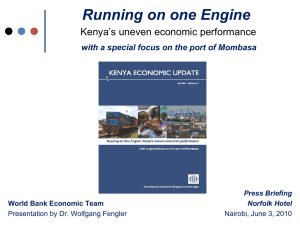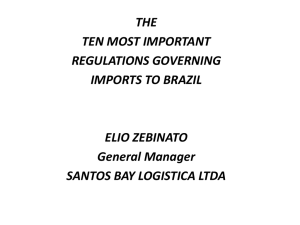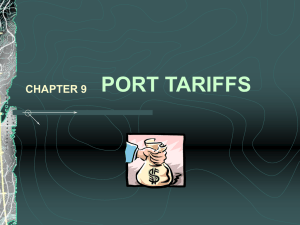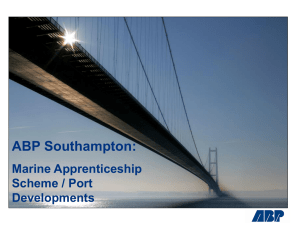documentation and role of cargo interveners in port operations
advertisement
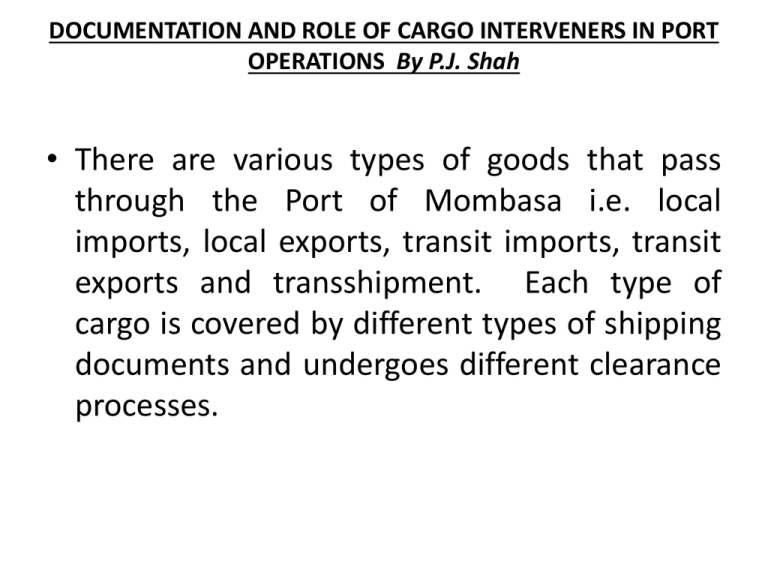
DOCUMENTATION AND ROLE OF CARGO INTERVENERS IN PORT OPERATIONS By P.J. Shah • There are various types of goods that pass through the Port of Mombasa i.e. local imports, local exports, transit imports, transit exports and transshipment. Each type of cargo is covered by different types of shipping documents and undergoes different clearance processes. • Similarly there are not only different types of vessels which bring cargoes to Mombasa i.e. conventional vessels, container vessels or ro/ro vessels which are handled by 14 shipping lines operating in Mombasa but also different sizes and types of containers in use e.g. 20FT or 40FT Standard, Reefer, Flat Rack, Open Top, High Cube, Platform etc. • • There are also different types of trucks in use for transportation of containers from the Port of Mombasa to their final destination such as single trucks, pulling Truck & Trailer, Semi-Trailer with sides or flat bed and covered body trucks. • Shipping lines offering containerized cargo service have regular sailings to Mombasa with frequencies of weekly or fortnightly or monthly calls whereas shipping lines offering conventional cargo service have either spot calls or inducement calls. • Hence for the purpose of today’s workshop I will confine myself to clearance of containerized local and transit imports as they not only constitute the bulk of the traffic passing through the Port of Mombasa but also face numerous challenges in clearance. • Clearing goods through the various interveners involved in the process i.e. Kenya Ports Authority (KPA), Kenya Revenue Authority (KRA), Kenya Bureau of Standards (KEBS), Kenya Plant Health Inspectorate Services (KEPHIS), Port Health Authority (PHA), Dairy Board of Kenya (DBK), National Biosafety Authority (NBA), AntiCounterfeit Agency (ACA) and Port Police and forwarding them to their final destination is not only a very complex but also lengthy and cumbersome exercise as will be seen from the flow charts which look like a Spider’s Web and which are annexed herewith as Appendix I and II • From these Flow Charts the delegates will observe that there are altogether 33 and 35 steps involved in the clearance process on local and transit containers respectively. • In order to make the delegates understand these processes reflected in the Flow Charts and save their time I have prepared a separate write-up on each of the steps involved in the clearance process which is annexed herewith as Appendix III & IV. • The shipping documents required for clearance of the two types of cargoes are as listed under item numbers (1) of Appendix III & IV. • Besides forwarding the relevant shipping documents the Importer must also remit adequate funds in advance to enable his Clearing Agent to pay the necessary Import Taxes if it is local cargo and other third party charges such as shipping line charges, port charges, transport charges etc. on a shipment of his. • The clearance process starts with the Importer. He has to ensure that he forwards a complete set of shipping documents listed under item numbers (1) of Appendix III & IV for a shipment to his Clearing Agent atleast 7 days prior to the expected date of arrival of the carrying vessel in Mombasa to enable the latter to clear and remove the containers from the Port and return the empty containers to the shipping line’s nominated depot in Mombasa within the following free periods given by the Kenya Ports Authority, Kenya Revenue Authority and shipping line concerned respectively: • Kenya Ports Authority: • Local imports -4 days from the day after the date of last sling • Transit imports -9 days from the day after the date of last sling • N.B.: The date of last sling means the date on which a vessel completes discharges of her cargo in the Port. • • • Kenya Revenue Authority Customs Entry -14 days from the date of the Shipping Lines: Local imports -9 to 14 days from the date of discharge of a container in the Port depending on the shipping line involved. • Transit imports -21 to 45 days from the date of discharge of a container in the Port depending on the destination and shipping line involved. • Similarly under Section 34 of The East African Community Customs Management Act 2004 an Importer is required to enter goods to a Customs entry within 21 days after the commencement of discharge of cargoes from the carrying vessel. • Under Section 42 of the same Act such overstayed goods are deemed to be deposited in the Customs Warehouse and if they are not lawfully removed from the Port or Customs Warehouse within 30 days after date of deposit Kenya Revenue Authority give a notice to the Importer by publication in the Kenya Gazette to remove them from the Port or Customs Warehouse within 30 days from the date of notice, failing which the goods are deemed to be abandoned to Kenya Customs for sale by Public Auction at Customs Warehouse, Kilindini • With so many interveners involved coupled with lengthy and cumbersome clearance procedures it becomes a real challenge for a Clearing Agent to clear and remove a local container from the Port within the free period allowed by KPA. • Whilst the free period on transit containers is adequate for the purpose of documentation, it again poses a challenge in its off-take from the Port • Failure to clear and remove containers from the Port and return the empty containers to a shipping line within the free periods stated above result in the Importer having to incur various demurrage charges enumerated below: • Port Authorities: 20FT Container Container • Re-Marshalling charge US$ 110.00 Storage Charge: • Local containers: – First 3 days per container per day – Next 8 days “ “ – Next 9 days “ “ – Thereafter “ “ 40FT US$ 165. US$ 30.00 US$ 60.00 US$ 35.00 US$ 70.00 US$ 40.00 US$ 80.00 US$ 45.00 US$ 90.00 • Transit containers: – First 2 days US$ 30.00 US$ 60.00 – Next 7 days US$ 35.00 US$ 70.00 – Next 6 days US$ 40.00 US$ 80.00 _ Thereafter US$ 45.00 US$ 90.00 • Shipping Lines: Container demurrage charge: First 7 daysUS$ 4.00 to US$ 10.00 AUS$ 8.00 to US$ 20.00 “ “ Next 7 days US$ 10.00 to US$ 20.00 US$ 20.00 to US$ 40.00 “ “ Thereafter US$ 14.00 to US$ 30.00 US$ 28.00 to US$ 60.00 “ “ • Customs Authorities: • Customs Warehouse Rent @ US$0.30 per Metric Ton per working day from 15th or 22nd day onwards, as the case may be, until the date the cargo is removed from the Port. • Experience shows that Importers are not only not conversant with the Importation rules and weight restrictions but are also ignorant of their rights and obligations. • For instance Importers ask their Shippers to load more cargo in a container than is allowed under the axle load restrictions existing in Kenya and the neighboring countries or load some personal items like a Television set or Refrigerator in the container without declaring them on the shipping documents or leave it to their Shippers to choose a shipping line for shipment of their goods from the Port of loading to the Port of discharge instead of doing it themselves or asking the Shippers to obtain freight rates, terms of carriage and destination charges from different shipping lines for comparative purposes. • As a result of this ignorance Importers have to either suffer indefinite delays in receipt of their goods or end up paying additional destination charges to the shipping line in Mombasa or penalties to KRA or additional transport costs to a local transporter. There have also been instances where • an Importer has paid a part amount in advance to his Shipper with the balance to follow before the carrying vessel arrives in Mombasa and then fails to raise the balance amount in time, and • an Importer is in possession of all the requisite shipping documents for a shipment but has no monies to pay for the destination charges when the shipment arrives in Mombasa; • an Importer has lost his monies and goods through improper sale contracts with the Seller or appointment of inefficient or unscrupulous Clearing Agent or Transporter. • In all these instances an Importer invariably fails to clear his shipment in time and thereby incurring heavy demurrage charges or ending up paying abandoning his shipment to Kenya Customs for sale by Public Auction. • Another common problem that has been experienced over the years and that is mainly with transit cargoes is that an Importer sends copies of shipping documents for the same shipment to more than one clearing agent in Mombasa, thereby not only creating a confusion as to who is the right clearing agent to handle his shipment but also ending up in either incurring additional costs or losing his shipment altogether. • Experience also shows that there is invariably a delay in receipt of shipping documents, especially from Importers in the neighboring countries as these documents are transmitted from the Seller’s bank to the latter’s correspondent bank and from the latter to the Importer’s bank. After securing release of the shipping documents from his bank the Importer then sends them to his clearing agent. • This movement of shipping documents from one bank to another bank takes time. There is also the tendency on the part of an Importer to not only delay securing release of the shipping documents from his bank but also remittance of funds in advance to his clearing agent for payment of import taxes or third party charges until a day or two before the expected time of arrival of the carrying vessel or at time after a vessel has arrived in Mombasa in order to save on finance costs. • It is therefore very essential that Importers both in Kenya and neighboring countries are sensitized on their rights and obligations including use of correct “INCOTERMS” for shipment of their goods. “INCOTERMS” stand for “International Commercial Terms”. • There are 13 commonly used “INCOTERMS” such as CIF, FOB etc. which are recognized by Customs and Courts around the world as the standard set of rules for global commerce. ‘INCOMTERMS” are not only rules of trade logistics that describe the responsibility of the buyers and sellers in delivery of physical goods but are in essence definitions and guidelines for sales contracts. • Whenever crisis arise in the Port of Mombasa, which is also a legally gazetted Customs Area, the business community starts pointing fingers at the management of KPA without analyzing how the crisis has come about. If a crisis has come about due to non-availability of berths or offloading/loading equipment or lack of labor or storage space then it is KPA who is responsible for the same but if it has come about due to delay in documentation or evacuation of cargo then it is either the Importer or KRA and other Government Agencies (OGAs) who are responsible for the same. • For the information of delegates KPA acts as stevedore to the shipping line by providing berthing space, loading/offloading equipment and labour and as a custodian of cargo to Importers by providing storage facility and security. • Although the entrance channel to the harbor was recently widened and container terminal berth lengths were increased by KPA this still does not allow the latter to accommodate container vessels with a carrying capacity of more than 6000 containers. • Hence the Port of Mombasa still continues to be a feeder port i.e. containers destined for Mombasa are discharged from panamax or post panamx vessels with carrying capacities of between 6000 to 10000 TEUs at ports like Salalah, Jeddah, Jebel Ali, Kofakan, Colombo, Durban, Port Klang or Singapore and then transshipped from there to Mombasa in smaller feeder vessels not exceeding 300 Metres in length and carrying capacity of 6000 TEUs. • On an average it takes between 6 to 8 weeks for a container to arrive in Mombasa after it has left the first Port of loading. • Whilst the roles of KRA and other Government Agencies (OGAs) are to protect government revenue and prevent importation of substandard or fake or banned goods and diversion of transit goods into the country unfortunately this is not done with a balancing act of protecting government revenue and at the same time facilitating unhindered flow of goods due to rigid and duplicated rules and lengthy procedures. Under the EACCM Act 2004 KRA is also mandated to regulate the clearing and forwarding industry by vetting and licensing Clearing Agents and Transit Transporters on an yearly basis. • There are over 1000 licensed Clearing Agents ranging from one or two man shows (Briefcase Agents) to International companies operating in Kenya handling both Seafreight & Airfreight. • The introduction of Simba System by KRA way back in 2005 has brought about some benefits to the Importers but the business community has yet to achieve the full benefit of the system as some of the remaining modules e.g. Paybox, Targeting, Importer profiling, automatic on-line bond cancellation etc. have yet to be introduced by KRA who are still insisting on presentation of hard copies of shipping documents. • Unfortunately human intervention is also there. It is hoped that when the Single Window System comes into operation sometimes next year the clearance process will become faster, smoother and flawless as it will not only be a paperless one but also one without any human intervention. • Similarly although 24/7 operations were introduced in the Port of Mombasa more than 3 years ago, the business community has yet to achieve full benefit of it as some of the parties to the agreement are still not working round the clock e.g. shipping lines, banks etc. Furthermore KRA are not doing verifications/scanning of cargo at night, thus defeating the purpose of working round the clock. • In order to cope with the increased volume of business passing through the Port of Mombasa against a backdrop of limited facilities KPA started nominating some private Container Freight Stations (CFSs) about 5 years ago to handle local containers on their behalf but here again Importers have yet to benefit in terms of savings in costs and clearance time. On the contrary there have been numerous complains about delays in transfer of containers from the Port to CFSs nominated by KPA and incurrence of unnecessary additional charges. • In conclusion; • the Authorities need to review their business processes by eliminating rigid and outdated rules and non-tariff barriers and embrace modern technology such as forensic audit in order to prevent leakage of revenue but at the same time be able to provide an efficient and customer friendly environment. For example KPA is not allowed to berth a vessel until a ship’s manifest is approved by KRA. At times this leads to delay in berthing of vessels and in turn delays in clearance of urgently needed cargo not to mention delay in collection of revenue by KRA. • the Importer needs to: • properly plan importation of his shipments; • understand his rights and obligations in maritime trade & transportation; • get familiar with import and weight restrictions; • appoint an efficient and reliable Clearing Agent; • ensure submission of shipping documents and funds in time to his Clearing Agent; and • appoint an efficient and reliable Transporter. Thank you all. By P.J. Shah Mombasa th 20 November 2012
